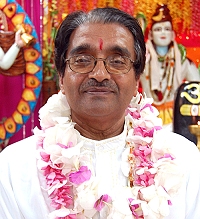From a satsang with Paramacharya of SWAHA, Pt. Hardeo Persad and Pt. Dr. Umesh Persad, Spiritual Leader, SWAHA Gyaan Deepak Kirtan Mandali
Saraswati Maataa, is a manifestation of the One Divinity, Ek Brahm. Devi symbolises the highest self, the state of positive qualities, purity, awareness and spirituality. She is the power of pure consciousness and the light of wisdom. Saraswati Devi represents kriyaa shakti, the power of enlightened activity. She is also considered the Goddess of learning, music, creativity and the arts. She is depicted as holding a book, mala and a musical instrument, the veena. These items are deeply symbolical of universal concepts; to be successful in our educational and academic pursuits, and in order to master knowledge and creativity, we need all three. The book represents knowledge, whether it is from a book, a teacher or guru; the mala represents the principle of repetition which is necessary for learning; and the veena represents the arts and creativity such as music and dance. This type of creative expression is important since music can help develop the brain and affects it in positive and unusual ways. In fact, it is advisable that children learn an instrument or how to sing. Even people affected by Alzheimer’s disease who have forgotten everything can temporarily regain a memory of a song from their childhood, if it is sung to them. Such is the power of music.
How should we perform music? The Sanskrit root of Saraswati is saras, which means ‘to flow’. When you are engrossed in singing a song, it automatically brings your mind to a state of one-pointedness and then to a state of rest. We aim to quiet the mind so that we can experience the true Self, which is beyond thought. We worship Saraswati Devi so as to develop a state of flow, not to the outer world, but an inward flow towards our consciousness. The ultimate goal is to maintain Saraswati, that constant flow at all times. Through music, we can generate that principle and power of Saraswati within us.
Music is important to bring about balance within our brains and bodies. However, music is also present throughout the universe in the form of vibration. Music is not just useful as entertainment; singing also creates its own vibration. The sages, in their wisdom, have incorporated music into devotions through kirtan and bhajan. In the Ramayan, Shree Raam explained to Vibheeshan that singing a bhajan is similar to the divine charioteer guiding the chariot of life to victory. The saint Chaitanya Mahaprabhu performed his kirtan with ek taara, an instrument with one string. Such was the power of the vibrations created by his music that lions and deer, sworn enemies, would sit side by side, forgetting their enmity. Spiritually, music can lift us and change us; as such, it is an integral part of devotions.
From a Hindu perspective, there are three classes of instrument: the drum, keyboard and strings. This can be compared to the three worlds, bhur, bhuvah and swah: physical, astral and causal, respectively. Moreover, the sounds of various musical instruments resonate at different frequencies that are associated with each of the chakras. In Hindu devotional music, there is a combination of all three classes of instrument, thus balancing the three types of vibrations. Of all instruments, however, the voice is considered the highest. When we sing, our body and voice are the instrument. It is through these musical instruments, whether internal or external, that we worship the Divine manifestation, Saraswati Devi. With one’s consciousness at a heightened state of awareness, far beyond the impure and worldly conditions of the mind, the attention then shifts to the changeless state which is the only reality. This is the victory we achieve by worship of the Divine Mother.



